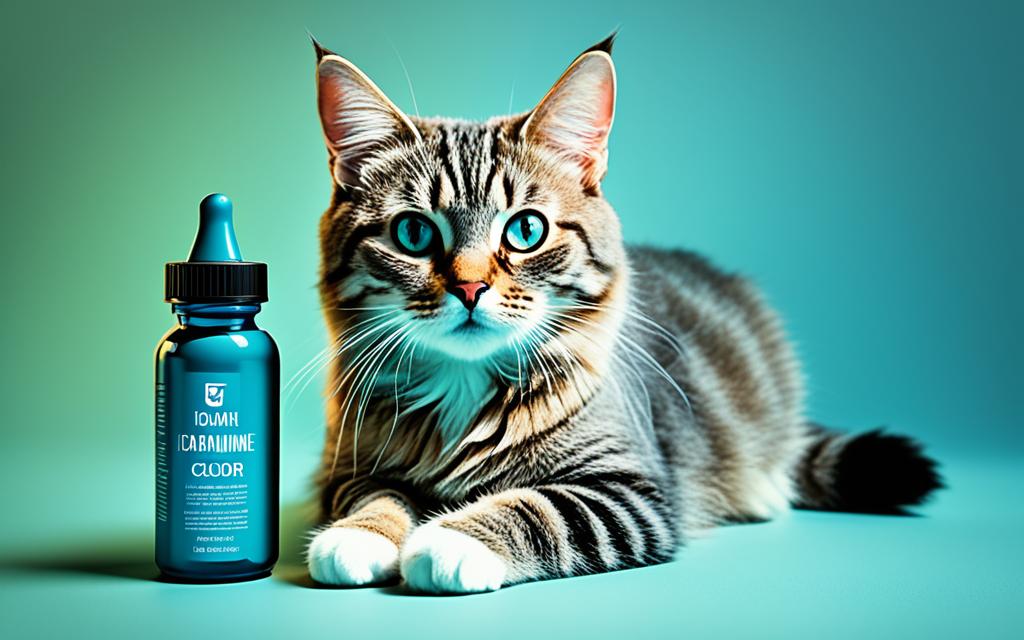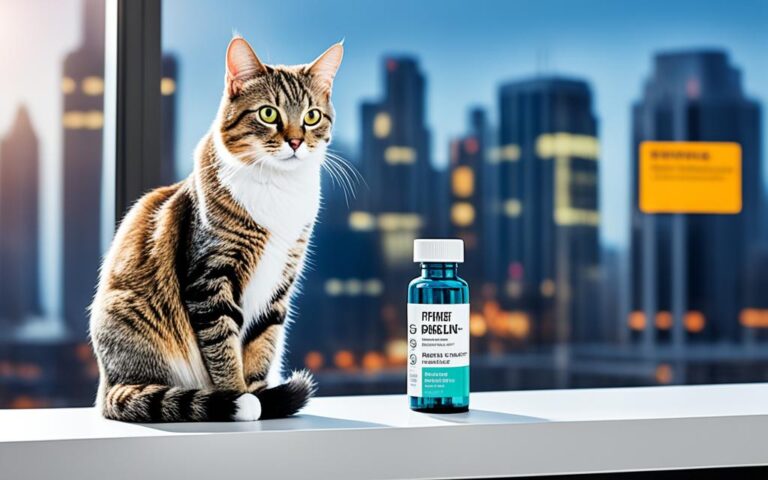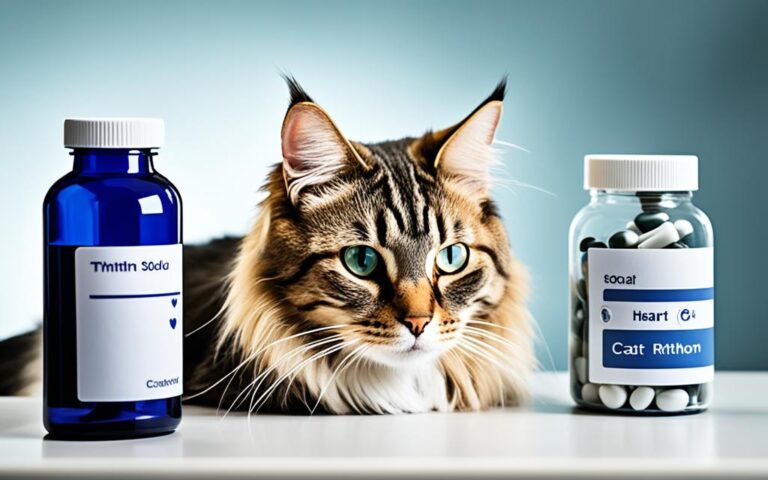Diphenhydramine Uses & Side Effects Guide for cat owners
If you’re a cat owner, you might not know this. A common over-the-counter drug called diphenhydramine is used for many things in cats1. This drug helps with allergies, travel sickness, and can make your cat sleepy when needed. But, it’s key to know the right amount to give, and the possible side effects and safety tips.
Key Takeaways
- Diphenhydramine is commonly used in cats, dogs, and other small animals to treat allergies, motion sickness, and as a mild sedative.
- The use of diphenhydramine in pets is considered “off-label” or “extra-label”, a common practice in veterinary medicine.
- Diphenhydramine can be administered orally through tablets, capsules, or liquids, as well as by injection in a hospital setting.
- Potential side effects include lethargy, dry mouth, urinary retention, vomiting, and diarrhea.
- Caution should be exercised when using diphenhydramine in pets with certain medical conditions or when combined with other medications.
Table of Contents
What is Diphenhydramine (Benadryl®, Vetadryl®) for Cats?
Diphenhydramine is an antihistamine that helps with allergies by blocking histamine at the H1 receptors2. It’s mostly used in dogs and cats for allergies and atopy. Atopy is when an animal is allergic to something in its environment2. In cats, it’s used “off-label.” This means it’s not the main use the medicine was first made for1.
Basic Information
Veterinary medicine often uses diphenhydramine to control allergies in pets2. It’s used in various animals like cats, dogs, and horses. Vets can use certain human drugs like this for animals, but under some rules2.
Common Brand Names
Popular names for diphenhydramine include Benadryl®, Vetadryl®, Banophen®, and more3. Benadryl® is well-known for people but not for pets by the FDA. Still, its active part is widely used in veterinary settings2.
“Diphenhydramine has been used for years in animals to manage allergic conditions such as hives, allergic reactions to insect bites, and allergic skin disease.”2
As an antihistamine, diphenhydramine stops histamine from acting, reducing allergy symptoms in pets2. It’s often found in veterinary care for managing allergies in various animals2.
Uses of Diphenhydramine for Cats
Diphenhydramine, known as Benadryl® or Vetadryl®, helps with many cat health issues. It is great for fighting allergies and allergic reactions. It also works against motion sickness and acts as a mild sedative2.
Allergies and Allergic Reactions
This medication is ideal for allergic conditions like hives and insect bites in cats. It stops histamine from causing itching, sneezing, and swelling. It’s popular for its low cost and safety when treating cat allergies2.
Motion Sickness
Some cats get sick from car rides or other trips. Diphenhydramine can help avoid motion sickness, bringing comfort to our cats4.
Mild Sedative
Diphenhydramine can make your cat sleepy, besides clearing allergies. It’s useful for calming them down during allergic reactions. This makes it valuable in several situations for cats2.
But remember, it’s not the best for treating pet anxiety from loud noises. For these cases, better medicines might be out there2.
Diphenhydramine is a key medicine for vets, helping with many cat health problems. Always talk to your vet to get the right advice on using this drug safely for your cat4.
| Condition | Diphenhydramine Use |
|---|---|
| Allergies and Allergic Reactions | Effectively manages symptoms like itching, sneezing, swelling, and hives. |
| Motion Sickness | Provides relief for cats experiencing motion sickness during travel. |
| Mild Sedative | Can help manage agitation associated with allergic symptoms. |
How to Administer Diphenhydramine to Cats
Benadryl®, known by many as Diphenhydramine, helps cats in different ways. You can give it to them by mouth, using pills, or liquids2. Yet, cats might find the liquid form not so tasty2.
If your cat won’t take it by mouth, a vet can use a needle to give it. They might put it in a vein, muscle, or under the skin2. Always do as your vet says when you give this medicine2.
Diphenhydramine works in around 30-60 minutes when taken by mouth.2 Before you give it, make sure to talk to a vet. They will help you with the right dose for your pet6.
| Dosage | Formulation | Availability | Pricing |
|---|---|---|---|
| 1 mg per pound of body weight | Tablets, capsules, or liquid | Available as Benadryl® or Vetadryl® | $0.05 per Vetadryl® tablet |
Look out for any signs of trouble when using Diphenhydramine. This includes things like sleepiness, dry mouth, trouble peeing, and more2. If your cat takes too much, get help fast2.
Keep Diphenhydramine in a place kids and pets can’t get to. The way it’s stored is also key2.

Always listen to what your vet tells you and watch how your cat reacts. This will make sure your cat is safe and well taken care of.
Diphenhydramine Dosage for Cats
Figuring out how much diphenhydramine, or Benadryl®, to give a cat is important. The usual dose is 1 mg for each pound the cat weighs. You should give it every 8-12 hours, only if needed7. Benadryl comes in 25 mg tablets. For a 12-pound cat, cut the tablet in half. For a cat under 7 pounds, cut it into quarters7.
Dosage Chart
| Cat Weight | Recommended Benadryl Dosage |
|---|---|
| 7 pounds | 7 mg |
| 10 pounds | 10 mg |
| 12 pounds | Approximately 4.8 ml of liquid Benadryl |
Keep in mind that Benadryl takes about one to two hours to work in cats7. You may use liquid Benadryl with a syringe. But, working out the right amount might be tough7.
Missed Dose Guidelines
If you forget to give your cat Benadryl, offer it as soon as you remember. But, if it’s almost time for the next dose, skip the missed one. Resume giving it at the regular times. Never give your cat two doses together or more than needed. This could cause bad effects7.
Always talk to a vet before you give Benadryl to your cat. They can help you figure out the right dose and how often to give it. Also, watch for any side effects like sleepiness, nervousness, dry mouth, trouble peeing, upset stomach, and vomiting7.
“Consultation with a veterinarian is always recommended before administering Benadryl to cats.”
Side Effects of Diphenhydramine in Cats
Diphenhydramine, known as Benadryl®, is a common antihistamine used in cats8. It helps with allergies, motion sickness, and can make cats sleepy. Cat owners should know its side effects.
Common Side Effects
Cats might get tired or have a dry mouth from diphenhydramine84. They also might not pee much. Some cats throw up, have diarrhea, or don’t want to eat8. A few might get really excited instead of getting sleepy4.
Rare Side Effects
Some severe side effects are uncommon but serious. If a cat takes too much, they might get really tired, stumble, have seizures, or breathe badly. This could lead to a coma or even death8. Also, don’t give diphenhydramine to cats that are breeding4.
Cat owners should watch their pets carefully after giving diphenhydramine. If the cat shows any bad signs, call the vet right away8. Knowing the risks and talking with a vet can ensure diphenhydramine is safe for cats.
“Diphenhydramine is a safe and effective medication for cats when used in the correct dosage, but cat owners should be vigilant for any adverse reactions and consult their veterinarian if any concerns arise.”
Precautions for Using Diphenhydramine in Cats
When you give cats diphenhydramine, it’s key to be careful. This is because it can react with some health issues and states9. Diphenhydramine, found in medicines like Benadryl®, needs special attention in cats with certain problems. These include glaucoma, big prostates, blocked bowels or bladders, and lung issues like COPD. Also, it’s important for cats with overactive thyroids, heart problems, or high blood pressure9.
Existing Health Conditions
Cats with certain health issues might feel diphenhydramine more. Vets could suggest less or a different treatment9. For instance, diphenhydramine might make glaucoma or big prostates worse. It might not be good for cats with blockages in their bowels or bladders9. And cats with COPD, thyroid issues, or heart conditions might have more side effects from it9.
Pregnancy and Lactation
When cats are expecting or nursing, diphenhydramine needs extra thought9. Large diphenhydramine amounts can lead to birth defects in animals. Plus, it gets into the breast milk of cats. Vets might suggest using less or a different antihistamine to keep the mom and her babies safe9.

Knowing these precautions and talking with a vet helps keep your cat safe with diphenhydramine9. It’s critical to think about your cat’s overall health and needs when using this medicine9.
Drug Interactions with Diphenhydramine
Diphenhydramine is known by the brand name Benadryl® and is often used to help cats with allergies10. But, it’s important to know that it can interact with other drugs when given to your pet1112.
When your cat takes diphenhydramine, be careful if they are also on drugs that slow down the brain, like barbiturates. It can make these other drugs stronger. It can also change how some drugs, like heparin and warfarin, work11. Always tell your vet about all the meds, supplements, or herbs your cat is taking11.
It’s especially important to be cautious if your cat is on tricyclic antidepressants or MAO inhibitors. This mix can cause issues like dry mouth, fast heart rate, and trouble peeing11. Adding more tranquilizers to the mix could make things worse, so avoid it11.
Also, diphenhydramine doesn’t mix well with some other drugs used in pets. For example, mixing it with certain drugs can cause serotonin syndrome, which is very dangerous. Signs of this include poor appetite and even blindness12.
Make sure to let your vet know about all the meds and supplements your cat is taking. This is key to avoid any bad drug reactions and keep your cat safe12.
Clearly, diphenhydramine can bring many benefits to your cat’s health. But, it’s vital to understand and manage any interactions with other drugs, supplements, or herbs. Talking to your vet is the best way to make sure diphenhydramine is safe for your cat111210.,,
Overdose Symptoms and Treatment
Diphenhydramine, or Benadryl, helps cats when used correctly. But too much can hurt them13. It’s best to give 1-2 mg for each pound they weigh. Giving more can lead to issues from extreme excitement to deep sadness13.
Too much Benadryl can make cats sleepy, unsteady, and tired13. But big overdoses are very serious. They might have seizures, stop breathing, fall into a coma, or die13. Look out for signs like tiredness, being upset, high blood pressure, weird heartbeats, throwing up, and not wanting to eat13.
If you think your cat took too much Benadryl, get help right away13. For seizures, they should get phenytoin, not diazepam or barbiturates13. Call your vet or an animal hospital if this happens13.
Getting quick medical help is key to fix a Benadryl overdose13. Learn the dangers and the right ways to treat them. This is how cat owners can keep their pets safe with this medicine13.
“Diphenhydramine overdose can be a serious and potentially life-threatening situation for cats. Seeking immediate veterinary care is crucial in such cases.”
To sum up, Benadryl can be good for cats if used carefully. Always know the right dose and look out for overdose signs13. Call the vet if you think your cat took too much. This quick response can save your pet13.
Comparison with Other Antihistamines for Cats
Both Benadryl® and Vetadryl® use the active ingredient diphenhydramine. It’s a top antihistamine choice for cats. But, other antihistamines deserve a look too. For specific cat issues like itching, hair loss, or travel sickness, veterinarians pick chlorpheniramine14.
Each antihistamine has its own pros and cons. For a quick itch relief, there’s Apoquel®. It’s great for dogs, with precise dosing and less side effects. But, it costs more than Benadryl, which you can buy easily14.
| Antihistamine | Efficacy | Cost | Side Effect Profile |
|---|---|---|---|
| Diphenhydramine (Benadryl®) | Helps dogs itch-free for a day14. | Prices start from $3.30 up to $22.0515. | Side effects like being tired or sleepy14. |
| Chlorpheniramine | A top choice for cat issues like itching or travel sickness16. | At $2.42, it’s the cheapest on the list with 100 Tablets15. | May make cats sleepy or thirsty, but they usually do okay16. |
| Apoquel® | Stops dog itching within 2 days by working very precisely14. | Is more costly than Benadryl14. | Riskier than Benadryl when it comes to infections and cancers14. |
The best antihistamine for your cat depends on their symptoms. Getting advice from a vet is key. They can recommend the right one for you16.
Benadryl is quite safe and can be adjusted depending on your cat’s needs. Apoquel, on the other hand, needs a steady dose. Benadryl may not work as quickly as Apoquel, which is fast acting14.
In the end, vets can help you choose the best antihistamine. They will take into account how well it works, the price, and the side effects. This helps you make a smart choice for your pet141615.
Monitoring During Diphenhydramine Treatment
When your cat is on diphenhydramine, keep a close eye on them. But, there’s no set checklist for monitoring their health17. The main thing is to watch for any unusual reactions or side effects17.
At home, make sure to watch your cat for signs like being overly tired or too active. They might also have dry mouth, throw up, or have diarrhea17. If anything worries you, tell your vet right away17.
Seeing the vet regularly is also a good idea. They can check if the medication is doing its job without causing any problems17. Plus, they might want to do some blood tests to keep track of your cat’s health17.
Always follow what the vet says and keep them in the loop about any changes you notice. This is key to making sure diphenhydramine is helping your cat safely17.
| Antihistamine | Uses | Side Effects |
|---|---|---|
| Chlorpheniramine | Effective against drug-induced, contact, and inhaled allergies, as well as miliary dermatitis in cats. | Sedation, excitement, trouble urinating, inappetence, vomiting, or diarrhea. |
| Loratadine | Targets hay fever and seasonal allergy symptoms like sneezing, nasal discharge, and itchy eyes in cats. | Sedation, excitement, trouble urinating, inappetence, vomiting, or diarrhea. |
| Meclizine | Serves as both an antihistamine and an anticholinergic, useful for common allergy symptoms in felines. | Sedation, excitement, trouble urinating, inappetence, vomiting, or diarrhea. |
| Diphenhydramine (Vetadryl) | Used to alleviate allergy symptoms in cats. | Sedation, excitement, trouble urinating, inappetence, vomiting, or diarrhea. |
Along with diphenhydramine, you can use things like antihistamine creams and medicated shampoos. They help manage allergy signs in cats18.
Just so you know, dogs typically take 2-4 milligrams of Benadryl for every kilogram they weigh13. The problem is, Benadryl pills are often much stronger, at 25mg or 50mg. So, giving the right amount to dogs can be tricky13. Overdose signs in dogs include tiredness, restlessness, high blood pressure or heart rate, and upset stomach13.
To wrap it up, watching your cat closely and seeing the vet often is vital when they’re on diphenhydramine. This way, you can make sure the treatment is going well and not causing any harm. It’s all about managing your cat’s health properly.
Storage Guidelines for Diphenhydramine
Storing diphenhydramine correctly keeps it strong and safe for cats. You can get this antihistamine in tablets, capsules, or liquids. It’s key to store it just right to keep it good for your cat.
Diphenhydramine, like Benadryl® and Vetadryl®, needs room temperature between 59°F and 86°F19. This helps keep it effective. It also must stay away from light. Light can make it less powerful.
For the liquid form, remember it can’t freeze19. Freezing changes how strong it is. This might not help your cat and could hurt them.
| Formulation | Storage Temperature | Light Exposure | Freezing |
|---|---|---|---|
| Tablets/Capsules | 15°C to 30°C (59°F to 86°F) | Protected from light | N/A |
| Oral Liquids | 15°C to 30°C (59°F to 86°F) | Protected from light | Protect from freezing |
Stick to these rules to keep your cat’s diphenhydramine strong. This way, you help your cat while avoiding bad effects.
Storing medicine right is one way to look after your cat. Keep in touch with your vet to know the best way to give and manage diphenhydramine or other meds for your cat19.
Conclusion
Benadryl®, or diphenhydramine, is an important medicine for cats. It helps with allergies, allergic reactions, motion sickness, and can calm them a bit20. Although it’s not its main use, vets can suggest it for your cat.
But, pet owners must watch for side effects like being too sleepy, breathing fast, or not peeing as much as usual20. It’s also key to get the dose right. Too much Benadryl can cause bigger problems like being too upset, not being able to use the bathroom, or having seizures20.
If you know when and how to use Benadryl, you and your vet can decide if it’s good for your cat20. This info, along with care in giving and watching your cat, makes Benadryl safer and better for managing your cat’s allergies and other health issues.
FAQ
What is diphenhydramine (Benadryl®, Vetadryl®) and how is it used for cats?
What are the common brand names for diphenhydramine?
What are the main uses of diphenhydramine in cats?
How is diphenhydramine administered to cats?
What is the appropriate dosage of diphenhydramine for cats?
What are the most common side effects of diphenhydramine in cats?
What precautions should be taken when using diphenhydramine in cats?
Are there any drug interactions to be aware of when using diphenhydramine in cats?
What are the symptoms of diphenhydramine overdose in cats, and how is it treated?
How does diphenhydramine compare to other antihistamines used in cats?
What monitoring is required while a cat is taking diphenhydramine?
How should diphenhydramine be stored for cats?
Source Links
- Diphenhydramine | VCA Animal Hospitals
- Diphenhydramine (Benadryl®, Vetadryl®) for Dogs and Cats
- Vetadryl Tablets for Dogs & Cats, 10-mg, 1 tablet
- Vetadryl (diphenhydramine)
- Cat Benadryl Dosage Calculator
- Can You Give Cats Benadryl? Benadryl for Cats Dosage
- Benadryl Dosage For Cats: Safety and Possible Side-Effects
- Mar Vista Animal Medical Center
- Benadryl for Cats | Great Pet Care
- Diphenhydramine (Benadryl, Vetadryl, Banophen, Diphenhist)
- Dangerous Pet Medication Mixes to Avoid
- ACCIDENTALLY GAVE DOG DOUBLE DOSE OF BENADRYL
- Apoquel Vs Benadryl: Pros & Cons of Both for Pets — Used Vet Equipment
- Cat Allergy Treatment & Itching Relief
- 6 Cat Allergy Medicines Prescribed by Vets | Great Pet Care
- Buy Cat Oral Antihistamines Tablets
- Benadryl for Dogs: Is Diphenhydramine Safe for Dogs? – PetPlace
- How Much Benadryl Should I Give My Do | The Village Vets







